- Home
- Larry McMurtry
Crazy Horse: A Life Page 2
Crazy Horse: A Life Read online
Page 2
He was born around 1840, by the Belle Fourche River, near Bear Butte, in what is now South Dakota. Chips, or Encouraging Bear, a Sioux medicine man, thought he had been born in the year when the Sioux had captured many horses from the Shoshones; this big raid occurred in 1841. Bear Butte was a favorite gathering place for several bands of the Sioux.
One aspect of Sioux nomenclature that is apt to confuse the reader (it is particularly confusing in Mari Sandoz’s biography) is that a warrior didn’t ordinarily acquire his permanent name until he had grown up and done something to earn it. Crazy Horse’s father was also called Crazy Horse; the father didn’t transfer this name to his son until he had proven himself valorous in battle, after which the father was known as Worm. So it was, too, with Sitting Bull, the Hunkpapa, whose childhood nickname was Slow and whose formal name was Jumping Badger; once the boy had counted coup, his father allowed him to become Sitting Bull.
He Dog, Short Buffalo, and several others mentioned that Crazy Horse was unusually light-complexioned, so much so that he was sometimes referred to as the Light-Skinned Boy. The same friends, and several whites as well, mentioned that he was not tall, and that he had sharp features. From an early age he was said to have a touch with horses, good at stealing them from other tribes and good, also, at capturing and breaking wild horses. Thanks to this skill he was for a time given the name His Horses Looking, but that name never caught on.
Worm, his father, was not a warrior. He was a healer, a shaman, a holy man, and an accomplished interpreter of dreams. Little is known about Crazy Horse’s mother—she was thought to be the sister of Spotted Tail, the Brulé leader who sat in many councils and was one of the first Sioux to conclude that it was futile to fight the whites. It was to Spotted Tail’s agency that Crazy Horse fled just before he was killed; but Spotted Tail, wanting no trouble, was stern with his nephew and was part of the escort that took him back to Fort Robinson.
It is worth noting that Crazy Horse was not born into one of the great families of the Sioux, families that had become great through much raiding and the capture of many horses. Worm’s lodge was humble. Stephen Ambrose argues correctly that the Sioux were a tolerant, noncompulsive people. Individuals were allowed to follow their own bent; that different people had differing abilities was recognized and accepted. Worm’s counsel was valued—he did not have to be a warrior to earn the tribe’s respect.
Crazy Horse, from the first, was indifferent to tribal norms. He had no interest, early or late, in the annual sundance rite, and didn’t bother with any of the ordeals of purification that many young Sioux men underwent, rituals that have been well recorded by George Catlin and others. Crazy Horse took his manhood as a given, and proved it in battle from an early age. His people may have thought him strange, but nonetheless he was let alone, allowed to walk in his own way.
His prominence today, as a symbol of Sioux resistance, owes much to his character, of course, but it also is in part a matter of historical timing. He fought his best in the last great battles—the Rosebud and the Little Bighorn—and then died young, in the last moments when the Sioux could think of themselves as free. By an accident of fate, the man and the way of life died together: little wonder that he came to be a symbol of Sioux freedom, Sioux courage, and Sioux dignity.
Though Crazy Horse was able to live many months and sometimes even years in the traditional Sioux way, raiding and hunting in turn, the way of life to which he had been born was dying even while he was a boy. By the time of his birth the whites were already moving in considerable numbers along the Holy Road (what we call the Oregon Trail); at first the pressure of white intrusion may have been subtle and slight, but it was present, and would be present throughout his entire life. The buffalo were there in their millions when he was born but were mostly gone by the time he died. Crazy Horse would have been a boy of five or six when Francis Parkman camped in a Sioux village whose leader was Old Smoke; it’s possible that young Curly—Crazy Horse’s nickname while a boy—was even living in the village when Parkman passed through. We don’t know that, but we do know that Francis Parkman was well aware that the way of life he was witnessing that summer—vividly described in The Oregon Trail—was a way of life that would soon be changing; indeed, would soon end.
As a lad Curly probably had no inkling of this, nor did most of his people, although the presence of whites in increasing numbers along the Holy Road was already an irritant. With such an abundance of game both north and south of the Platte River, it may be thought that tribal life could have gone on with little change. But the lives of hunting people are never that secure. There was, to be sure, a lot of game; but it didn’t meekly present itself to those who hunted it. The game still had to be found and killed—then as now, animals were quick to shift away from places where they were heavily hunted. From the standpoint of the Sioux, Cheyenne, and Pawnee hunters who lived by what they killed, the white invasion was almost immediately destructive.
Very early too, even from the time of the first fur traders, an unfortunate symbiosis began to develop between tribes and traders. The whites had goods that the Indians wanted—goods on which they soon became dependent. Lord Raglan, the sharp-spoken English anthropologist and myth theorist, has commented acutely on the fragility of hunting cultures in a book called How Came Civilization? He points out that peoples who had been adept for generations at making bone fishhooks lose this skill very quickly once they are supplied with metal fishhooks. The Plains Indians soon came to like needles and other small tools that could be had in quantity from traders who frequented the forts and gathering places along the Holy Road.
Sitting Bull, the very tough-minded Hunkpapa, perhaps had the clearest vision of the ultimate destructiveness of trade with the white man; he saw very early that it would soon destroy Sioux independence, and he was right. He always counseled his people to have nothing to do with the whites and to stay as far away from them as possible. But, unfortunately, the westward course of empire (a fine phrase that covered over much brutality) left the Sioux little choice. In time, and not much time, the whites were everywhere.
As soon as the first forts were established along the Holy Road, and certainly after the great Laramie council of 1851, there were what came to be called ration Indians, of coffee coolers, those who lived by the forts and let go the strenuous, uncertain life of the hunt; in giving up the life of the warrior Sioux, they soon forfeited much of the respect of those tribesmen who still hunted and fought.
By 1850 all the Plains Indians had to reckon with the fact that though the whites were going through, they weren’t going away. They brought many things that the Indians could use, but they also brought something that no tribe wanted: smallpox. The terrible epidemic that struck the Missouri River tribes in 1837, just a few years before Crazy Horse was born, nearly wiped out the Mandans and drastically weakened the Blackfeet.
The whites came, their disease came, and the game left—not all of it, of course, but even a slight diminution was enough to affect the lives of hunting peoples. Friction steadily increased along the Holy Road; immigrant trains were attacked, the occasional immigrant killed. There was no full-scale warfare yet, just an ominous, continuous rumbling. From the Santa Fe Trail in the south to Fort Union in the north there were clashes, disturbances, apprehension. The Indians, who had at first been friendly with the whites, soon found their patience beginning to fray; the whites, for their part, had never had much patience with the Indians. The Plains Indians were beginning to be seen as mobile impediments; what they stood in the way of was progress, a concept dear to the American politician.
It was to explain this crucial concept—progress—and, by so doing, smooth the way for manifest destiny by speeding the emigrants safely on through to Oregon or California, that the government thought best to convene the great council that was held at Fort Laramie in the summer of 1851. If Crazy Horse was there, which is likely, he was a boy just short of adolescence and was probably drinking in the sights.
There was an abundance of sights to drink in, too. The Fort Laramie council probably drew the greatest assembling of native peoples—or at least, of Plains peoples—prior to the massing at the Little Bighorn a quarter of a century later. I have read many descriptions of the Fort Laramie council, a conclave at which many traditional enemies sat together, but the passage that best suggests the splendor and the wildness of the tribes as they then were is Afric rather than American. Here is Wilfred Thesiger’s account of a similar gathering in Addis Ababa in 1916, when his father was British ambassador there:
Each feudal lord was surrounded by levys from the province where he ruled. The simple fighting men were dressed in white but the chiefs wore their full panoply, lion’s mane headdresses, brilliant velvet cloaks stiff with silver and golden ornament, long silk robes in many colors and great curved swords. All carried shields, some embossed with silver and gilt, and many carried rifles. The Zulu impis parading before Chaka, or the dervishes drawn up to do battle in front of Omdurman, could have appeared no more barbaric than this frenzied tide of men which surged past the royal pavilion throughout the day, to the thunder of the war drums and the blare of the war horns. This was no ceremonial review. These men had just returned from fighting for their lives, and they were still wild with the excitement of those frantic hours. The blood on the clothes which they had stripped from the dead and draped over their horses was barely dry. They came in waves, horsemen half concealed in dust and a great press of footmen. Screaming out their deeds of valor and brandishing their weapons they came right up to the steps of the throne. Above them, among glinting spear points, countless banners dipped and waved. . . .
Something rather like this was to occur in Montana, twenty-five years later, on the twenty-fifth of June, 1876. I quote Thesiger not only because he has left a fine description of native splendor, but also because he mentions the Zulus and the dervishes. The Custer battle was only one of the occasions, in the last quarter of the nineteenth century, on which native peoples fought one last victorious fight against the colonizers. Only a little later, on January 27, 1879, twenty thousand Zulus overwhelmed the British garrison at Islandwana, killing thirteen hundred men. In February of 1885 the dervishes overran General Gordon at Khartoum. Geronimo and his eighteen men surrendered in September of 1886, and Sitting Bull was shot and killed by two Indian policemen in the last days of 1890, with the Wounded Knee massacre occurring just afterward.
The great council at Fort Laramie in 1851, which was supposed to mark the end of the United States government’s conflict with the Plains Indians, was, in fact, only an especially colorful beginning.
It was an odd beginning, too. There were many highly respected Indian leaders at this council. What immediately became clear—to the Indians, but not to the whites—was that whites and Indians had very different ideas about what a chief was and what powers he might have. All societies have leaders; certainly the Sioux had several of uncommon ability, but rarely did any of them have the direct power of command that was the mark of a “chief” in white culture. The whites had a commander-in-chief who could give orders and expect to have them obeyed. There was, far away, a czar of all the Russias, who had great power over his people; he could also give orders and expect to have them obeyed. The peace commissioners at Fort Laramie seemed to assume that some such leader could be found among the Sioux—a czar of all the Sioux, as it were, and one who, if possible, could boss the Pawnees, the Cheyennes, the Crows, the Shoshones, and the Arapahos as well. This foolish assumption haunted the government’s relations with native peoples all through the nineteenth century and well into the twentieth. The Indians had no political mechanism for selecting such a leader, and no intention of obeying him should he appear. That being the case, the whites simply chose for them, passing over the much-respected Old Smoke and settling on an able and sensible Brulé named Conquering Bear (or, sometimes, Whirling Bear).
Having chosen the chief of their choice, the U.S. government agreed to pay the tribes an annuity of $50,000 in goods, for which they expected to get safe passage for immigrants along the Holy Road—peace in their time, as it were. The commissioners went home well satisfied; the Indians divided their presents and went back to their customary lives. No one, of any tribe, had any intention of obeying Conquering Bear, unless his wish happened to coincide with what they wanted. They may not even have understood that the whites harbored such a foolish expectation. Conquering Bear may have supposed that he was now chief of the Brulés, and possibly, at a stretch, of the Oglalas, but even of the Oglalas he would have been far from sure. As for being chief of all the Sioux, much less of all the Plains Indians—well, that was a ridiculous notion that no one took seriously. There was no chief of all the Sioux—never had been, never would be.
Perhaps the most interesting thing to come out of the Fort Laramie council was the government’s misreading of what chieftaincy meant among the Plains Indians. They could not rid themselves of the expectation that a Sioux or a Cheyenne or a Pawnee, once called a chief, would then begin to behave exactly like a white CEO, bossing people around, initiating, restraining. They were unprepared to recognize that Indian societies didn’t work that way. The Sioux were highly individualistic people; though they often acted in concert on hunts and raids, at other times each man simply went his own way. Crazy Horse ignored the sundance, spent a lot of time by himself, raided when he wanted to. If he could find a few warriors willing to go raiding with him, that was fine; but if no one in camp was in a martial mood, he went alone.
The issue of chieftaincy remains ticklish because, through long usage, most of those who read about the Plains Indians, and some of those who write about them, come to assume that the Indians who proved most successful in councils and parleys with the whites were really chiefs back home, when in many cases they were not, Red Cloud being a famous example. The struggle for the Bozeman Trail and the Powder River country is often called Red Cloud’s war, and he is commonly thought to have won that war when the government closed three forts in 1868. But many of the Sioux who knew him were merely amused by the notion that Red Cloud was a chief, although they did concede that personally he was valorous enough. But he didn’t sit in the council of elders and wise men called the Big Bellies. The Sioux may have noticed problems with Red Cloud’s character—vanity, for example—that escaped the whites, for a time, though they certainly didn’t escape agent Valentine McGillycuddy, who had a long and bitter struggle with him in the years after Crazy Horse’s death. Red Cloud’s name is on the plaque at the Fetterman battlefield, though several authorities doubt that he fought in that battle; nor was he at the Little Bighorn, though in extreme old age he seems to have believed that he was.
The whites decided Red Cloud was a big chief because he was able in dealing with them. He was prominent in many parleys and conferences, went to Washington several times, and even made a speech at Cooper Union, in New York City, in 1870. Red Cloud and Spotted Tail both recognized quickly that the whites were too powerful to oppose directly—much too powerful. Whatever might be said in the parleys, and whatever was written on the papers, the whites meant to win; they were going to take what they wanted, which, in the end, was all the country that the native peoples had once inhabited. Red Cloud may not have been a big chief to his own people, but he had, early on, made a true reckoning of white ability and white intent. The bottom line, for Red Cloud, was that the whites were going to take it all. Thus, in the big council of 1874, over the Black Hills, where gold had been discovered by the ubiquitous General Custer, Red Cloud advocated selling, and for a big price. Clearly the whites were going to take the Black Hills anyway—why not get some money and a lot of goods?
This council in 1874 was the one to which Crazy Horse—who attended no councils—may have sent Little Big Man as his representative. Little Big Man (the Sioux warrior, not the character in Thomas Berger’s novel) raced into the company almost naked, announcing that he would shoot anyone who wanted to sell the Black Hills. Red Clou
d had just been about to launch into one of his stem-winding orations when Little Big Man arrived. Sitting Bull was a reluctant parleyer, but Crazy Horse went him one better: he just didn’t parley—not until 1877, when he finally came in. Before that he stayed away, amid his caves and holes, which is one reason so much of his life is simply a mystery. But this avoidance of parleys may also have meant that he never made the kind of hardheaded assessment of white character and white intentions that Red Cloud, Spotted Tail, and Sitting Bull arrived at early on.
4
WHAT CRAZY HORSE did learn about whites while still quite young was the destructive force of their caprice. This knowledge came to him because of the famous incident of the Mormon cow (or, possibly, the Mormon ox). As usual, we can date the incident—August 17, 1854—only because a lot of white people got killed, thirty-one this time.
Conquering Bear, the Brulé leader whom the whites had hoped to make the czar of all the Sioux, was living, along with some Minniconjous and some Oglalas, near the camp of Old Smoke, the much-respected Sioux leader, when a party of Mormons came through, one of them driving a lame cow. The Sioux camp was not far from Fort Laramie. The lame cow wandered through this camp and a Minniconjou warrior named High Forehead (or Straight Foretop) killed her. Many immigrant trains passed over the Holy Road that summer, and the young Sioux warriors pestered them, nipping a cow here and a horse there. Some of their prizes were a good deal more to be desired than this lame cow.

 Terms of Endearment
Terms of Endearment Some Can Whistle
Some Can Whistle All My Friends Are Going to Be Strangers
All My Friends Are Going to Be Strangers Lonesome Dove
Lonesome Dove Crazy Horse: A Life
Crazy Horse: A Life Comanche Moon
Comanche Moon Cadillac Jack
Cadillac Jack Streets of Laredo
Streets of Laredo Duane's Depressed
Duane's Depressed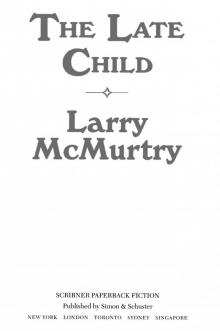 The Late Child
The Late Child Texasville
Texasville Rhino Ranch
Rhino Ranch Pretty Boy Floyd
Pretty Boy Floyd Telegraph Days
Telegraph Days The Evening Star
The Evening Star The Last Kind Words Saloon
The Last Kind Words Saloon Buffalo Girls
Buffalo Girls Horseman, Pass By
Horseman, Pass By Boone's Lick
Boone's Lick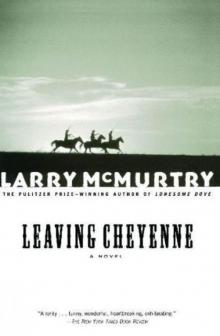 Leaving Cheyenne
Leaving Cheyenne Sin Killer
Sin Killer The Lonesome Dove Chronicles (1-4)
The Lonesome Dove Chronicles (1-4) The Desert Rose
The Desert Rose Moving On
Moving On Dead Man's Walk
Dead Man's Walk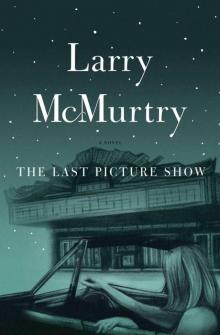 The Last Picture Show
The Last Picture Show When the Light Goes
When the Light Goes Streets Of Laredo ld-2
Streets Of Laredo ld-2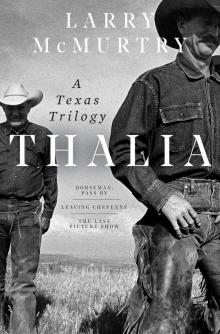 Thalia
Thalia Crazy Horse
Crazy Horse Oh What a Slaughter
Oh What a Slaughter The Colonel and Little Missie
The Colonel and Little Missie Zeke and Ned
Zeke and Ned Telegraph Days: A Novel
Telegraph Days: A Novel The Last Kind Words Saloon: A Novel
The Last Kind Words Saloon: A Novel Comanche Moon ld-4
Comanche Moon ld-4 The Berrybender Narratives
The Berrybender Narratives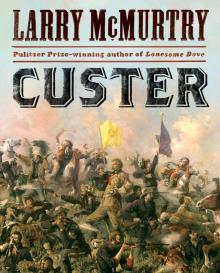 Custer
Custer